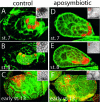Developmental origin and evolution of bacteriocytes in the aphid-Buchnera symbiosis
- PMID: 14551917
- PMCID: PMC212699
- DOI: 10.1371/journal.pbio.0000021
Developmental origin and evolution of bacteriocytes in the aphid-Buchnera symbiosis
Abstract
Symbiotic relationships between bacteria and insect hosts are common. Although the bacterial endosymbionts have been subjected to intense investigation, little is known of the host cells in which they reside, the bacteriocytes. We have studied the development and evolution of aphid bacteriocytes, the host cells that contain the endosymbiotic bacteria Buchnera aphidicola. We show that bacteriocytes of Acyrthosiphon pisum express several gene products (or their paralogues): Distal-less, Ultrabithorax/Abdominal-A, and Engrailed. Using these markers, we find that a subpopulation of the bacteriocytes is specified prior to the transmission of maternal bacteria to the embryo. In addition, we discovered that a second population of cells is recruited to the bacteriocyte fate later in development. We experimentally demonstrate that bacteriocyte induction and proliferation occur independently of B. aphidicola. Major features of bacteriocyte development, including the two-step recruitment of bacteriocytes, have been conserved in aphids for 80-150 million years. Furthermore, we have investigated two cases of evolutionary loss of bacterial symbionts: in one case, where novel extracellular, eukaryotic symbionts replaced the bacteria, the bacteriocyte is maintained; in another case, where symbionts are absent, the bacteriocytes are initiated but not maintained. The bacteriocyte represents an evolutionarily novel cell fate, which is developmentally determined independently of the bacteria. Three of five transcription factors we examined show novel expression patterns in bacteriocytes, suggesting that bacteriocytes may have evolved to express many additional transcription factors. The evolutionary transition to a symbiosis in which bacteria and an aphid cell form a functional unit, similar to the origin of plastids, has apparently involved extensive molecular adaptations on the part of the host cell.
Conflict of interest statement
The authors have declared that no conflicts of interest exist.
Figures





References
-
- Baumann P, Moran NA, Baumann L, editors. Bacteriocyte-associated endosymbionts of insects. In: Dworkin M, editor. The prokaryotes [online] New York: Springer; 2000. Available: http://link.springer.de/link/service/books/10125/
-
- Buchner P, editor. Endosymbiosis of animals with plant microorganisms. New York: John Wiley; 1965. 909 pp.
-
- Caillaud CM, Rahbé Y. Aposymbiosis in a cereal aphid: Reproductive failure and influence on plant utilization. Ecol Entomol. 1999;24:111–114.
-
- Chang CC, Dearden P, Akam M. Germ line development in the grasshopper Schistocerca gregaria: Vasa as a marker. Dev Biol. 2002;252:100–118. - PubMed
MeSH terms
Substances
LinkOut - more resources
Full Text Sources

